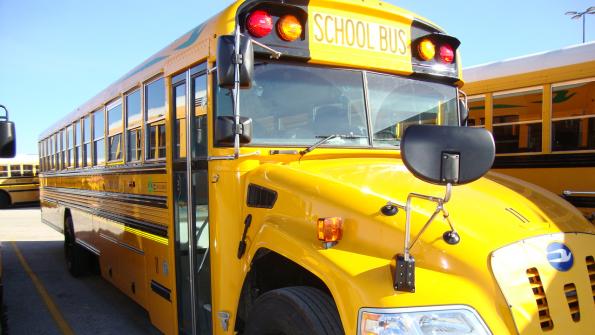Green light priority traffic technology possible solution for school bus driver shortages
Across the United States, communities of all sizes and regions are facing school bus driver shortages. New research from Georgia shows promise in a technological solution to this widespread problem.
A pilot program conducted this spring at the Fulton County School System in Alpharetta, Ga. tested out devices that give vehicles the right-away at traffic signals. Two school buses, one diesel and the other powered by propane, were outfitted with onboard units that communicate via cellular network with 62 traffic signals along each route, turning the lights green on approach.
The program demonstrated “a clear and measurable reduction in route travel time for both school buses as a result of the decrease in total number of unscheduled stops and an increase in average speed of the bus along the route,” notes a report about the findings prepared by Kimley-Horn, a Boise-based consulting firm. “Less time on the road and fewer bus stops equates to direct safety and mobility benefits for the bus driver, students, parents, nearby motorists, and the (Fulton County School System). The pilot program enabled bus drivers to more frequently arrive at school on time and allow students to eat breakfast before going to class and starting their day.”
Specifically, vehicles equipped with the green light technology saw a 40 percent decrease in unscheduled stops, a 13 percent reduction overall in trip times, a 13 percent improvement in fuel economy and a 12 percent reduction in harmful emissions.
With fewer stops, students are safer—studies have shown that, when on the bus, kids are more likely to stand up or engage in unsafe behavior during stops: “The pilot program was able to reduce the likelihood that students engage in these types of activities and generally created a more safe environment onboard the school bus,” the report says.
And with quicker trips, more students were able to enjoy the district’s breakfast program before heading into class, a statement about the findings reads. Further, higher average travel speeds and fewer stops also reduced the amount of fuel used. In correlation, the district’s carbon emissions were also reduced.
Beyond cutting down on travel time and streamlining the district’s processes, the findings pose a possible solution for districts elsewhere facing administrative challenges.
“With about 86 percent of the nation’s school districts experiencing a driver shortage, improving the safety and efficiency of the fleet is critical,” said Trey Stow, director of transportation and operations at Fulton County Schools. “The pilot showed we can use this technology to make our fleet more efficient and serve more students safely in a shorter amount of time, all while reducing our fuel bill and helping the environment.”
A recent survey from HopSkipDrive, a school ride-service company, puts the percentage of schools dealing with bus driver shortages a little higher—nine out of every 10 respondents in the survey said they’re dealing with administrative challenges.
“The pilot program demonstrates the ability of the public and private sectors to work together and develop new and creative solutions for improving school transportation safety and efficiency,” said Bryan Mulligan, president of Applied Information. “These solutions applied across the national fleet of approximately 500,000 school buses would prove significant time and fuel savings as well as substantial reductions in CO2 emissions.”








Gloss